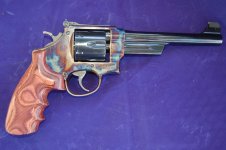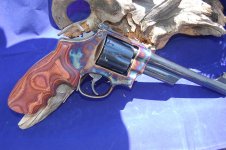I've never bought into the sun fading of case colors, but many do, keep 'em stored out of the direct sun if it it seems to be a valid point to you.
Simple wear from handling is what takes the color off. The color itself is only microns thick (if micron is a real measurement). The hardeness,,the real reason for the process will be anywhere from near nothing to a few .000". Wearing away the colors leaves the hardness in the surface.
The harder surface is what many times makes the handled and polished up surface appear nickle plated. Harder metal takes a brighter polish.
Durability can vary. Some parts (were)are casecolored intentionally with no surface hardness. Cosmetic color on the surface only. Warpage is a greater factor when the hardening temps are introduced.
Those soft colored parts will wear their colors off very quickly from my experience.
Sometimes as quick as during re-assembly of the guns especially if you have some problem and have to dis-assemble and reassemble a couple of time toget a single trigger of ejector to work.
Kind of a nice gently used but not abused look to them,,but the customers were certainly not wanting that (not all of them anyway).
Others were much more durable,,and hard like they should be.
A coating was nothing more than (orange) shellac) then.
Everything that was case colored that was coated, was coated with that. Some jobs/restorations were not coated.
We applied a thinned coating quickly by hand with medical cotton swabs. That was it. The orange shellac enhances the colors a bit over white shellac.
I think LC Smith and some others used it originally. Cheap, dries quick, looks good.
But lots of different clear coatings are used now and some are bake on type and are very tough.
These can also be very tough to re-move the remnants of (as opposed to shellac or laquers) when time comes to re-coat the metal as the coatings wear,,,and they will.
Take your pick,,or leave the surface uncoated. Some older mfg's coated their C/C frames,,some did not. On a custom you do what you want of course.
But case colors them selves are not a very durable finish or coating. There just plain isn't much of anything there.
Re-fitting after hardening can be nothing to do or some bending of metal.
Hopefully not the latter too much as there is a limit to what you can do to C/hardened steel. If you guess wrong, you probably know what happens. But you can bend parts to a degree. It takes some experience like everything else to know what you can and cannot do or attempt.
Better to anneal and refit and re-color than to crack the part.
Most of the purveyors have it pretty well under control but it still happens. It takes some confidence to wedge open the wall of a freshly casecolor hardened 86 frame so the bolt will fit back into the rails. Better the condition doesn't happen in the first place.
The toughest case colors as far as wear resistance that
I think I've seen were those done by Don Menk when he ran Case Color Co. in Ohio.
He's retired & out of business now. Ran one 'style' of color or pattern if you want to call it that. But they wore very well and he gave good metal hardness depth.






